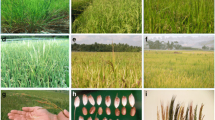Summary
In breeding crop varieties for stress environments, it must be decided whether to select directly, in the presence of stress, or indirectly, in a nonstress environment. The relative effectiveness of these two strategies depends upon the genetic correlation (r g ) between yield in stress and nonstress environments and upon heritability in each. These parameters were estimated for grain yield of 116 random oat lines grown in nonstress, P-deficient, N-deficient, and late-planted environments. Estimates of r g between yield in nonstress and yield in P-deficient, N-deficient, and late-planted environments were 0.52±0.24, 1.08±0.16, and 0.06±0.24, respectively. No consistent relationship between heritability and environment mean yield was observed. Direct selection in the presence of stress was predicted to be superior for yield in low-P and late-planted environments, but indirect selection in high-N environments was predicted to be as effective as direct selection in producing yield gain in low-N environments. These results confirm that neither high-yield environments nor environments in which the heritability of yield is maximized are necessarily optimum when the goal is to maximize yield gain in stress environments.
Similar content being viewed by others
References
Allen, F.L., R.E. Comstock & D.C. Rasmussen, 1978. Optimal environments for yield testing. Crop Sci. 28: 747–751.
Anderson, R.L. & T.A. Bancroft, 1952. Statistical theory in research. McGraw-Hill Book Co., New York.
Atlin, G.N. & K.J. Frey, 1989. Selecting oat lines for yield in low-productivity environments. Submitted to Crop Sci.
Brown, J.G., R.B. Clark & W.E. Jones, 1977. Efficient and inefficient use of phosphorus by sorghum. Soil Sci. Soc. Am. J. 41: 747–750.
Caradus, J.R., 1982. Genetic differences in the length of root hairs in white clover and their effect on phosphorus uptake. In: A. Scaife (Ed.), Plant Nutrition, 1982, pp. 84–88. Commonw. Agric. Bur., Farnham House, U.K.
Colville-Baltenberger, D.C. & K.J. Frey, 1987. Genotypic variability in response of oat to delayed sowing. Agron. J. 79: 813–816.
Dickerson, G.E., 1962. Implications of genetic-environmental interaction in animal breeding. Anim. Prod. 4: 47–63.
Falconer, D.S., 1952. The problem of environment and selection. Am. Nat. 86: 293–298.
Falconer, D.S., 1981. Introduction to quantitative genetics. 2nd Ed. Longman Group Ltd., London.
Fernando, R.L., S.A. Knight & D. Gianola, 1984. On a method of estimating the genetic correlation between characters measured in different experimental units. Theor. Appl. Genet. 67: 175–178.
Frey, K.J., 1964. Adaptation reaction of oat strains selected under stress and non-stress environmental conditions. Crop Sci. 4: 55–58.
Gabelman, W.H. & G.C. Gerloff, 1983. The search for and interpretation of genetic controls that enhance plant growth under deficiency levels of macronutrients. Plant Soil 72: 335–350.
Gotoh, K. & S. Osanai, 1959. Efficiency of selection for yield under different fertilizer levels in a wheat cross. Jpn. J. Breeding 9: 173–178.
Johnson, G.R. & K.J. Frey, 1967. Heritabilities of quantitative attributes of oats (Avena sp.) at varying levels of environmental stress. Crop Sci. 7: 43–46.
Knapp, S.J., W.W. Stroup & W.M. Ross, 1985. Exact confidence intervals for heritability on a progeny-mean basis. Crop Sci. 25: 192–194.
McNeill, M.J. & K.J. Frey, 1974. Gains-from-selection and heritabilities in oat populations tested in environments with varying degrees of productivity. Egypt. J. Genet. Cytol. 3: 79–86.
Pederson, D.G. & A.J. Rathjen, 1981. Choosing trial sites to maximize selection response for grain yield in spring wheat. Aust. J. Agric. Res. 32: 411–424.
Robertson, A., 1959. The sampling variance of the genetic correlation coefficient. Biometrics 15: 469–485.
Rosielle, A.A. & J. Hamblin, 1981. Theoretical aspects of selection for yield in stress and non-stress environments. Crop Sci. 21: 943–946.
Rumbaugh, M.D., K.H. Asay & D.A. Johnson, 1984. Influence of drought stress on genetic variances of alfalfa and wheat-grass seedlings. Crop Sci. 24: 297–303.
Scheinberg, E., 1966. The sampling variance of the correlation coefficients estimated in genetic experiments. Biometrics 22: 187–191.
Via, S., 1984. The quantitative genetics of polyphagy in an insect herbivore. II. Genetic correlations in larval performance within and among host plants. Evolution 38: 896–905.
Wych, R.D., R.L. McGraw & D.D. Stuthman, 1982. Genotype x year interaction for length and rate of grain filling in oats. Crop Sci. 22: 1025–1028.
Yamada, Y., 1962. Genotype by environment interaction and genetic correlation of the same trait under different environments. Jpn. J. Genet. 37: 498–409.
Author information
Authors and Affiliations
Additional information
Dep. of Agronomy, Iowa State Univ., Ames, IA 50011; USA, Journal Paper no. 13101. Project 2447.
Rights and permissions
About this article
Cite this article
Atlin, G.N., Frey, K.J. Predicting the relative effectiveness of direct versus indirect selection for oat yield in three types of stress environments. Euphytica 44, 137–142 (1989). https://doi.org/10.1007/BF00022608
Received:
Accepted:
Issue Date:
DOI: https://doi.org/10.1007/BF00022608




